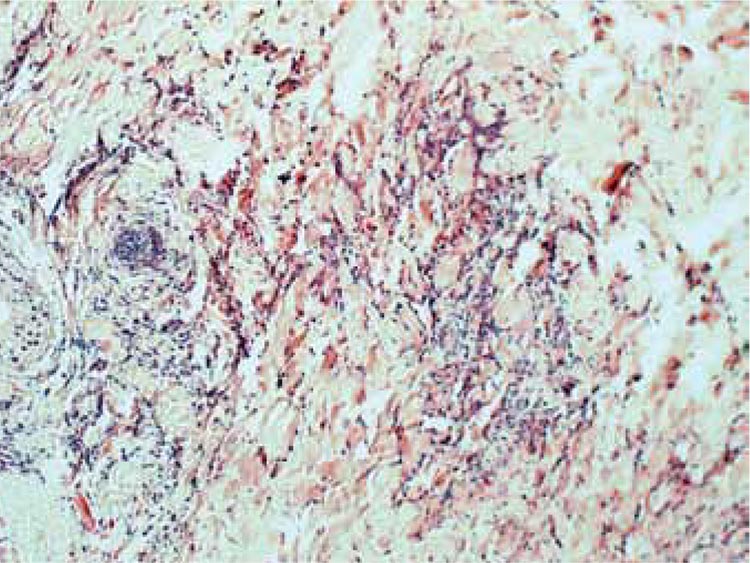Wells´ syndrome (eosinophilic cellulitis) associated with Helicobacter pylori infection
Keywords:
Wells’ syndrome, eosinophilic cellulitis, eosinophilia, Helicobacter pyloriAbstract
Wells’ syndrome is a rare eosinophilic dermatitis first described 40 years ago, with a wide clinical spectrum and varied histology according to the stage of the cutaneous lesions, associated with numerous endogenous and exogenous factors, including infectious and gastrointestinal diseases.
We present the case of a woman with a 10-day history of edematous, itching and recurrent plaques in limbs with pustules in the right cheek, chest, abdomen and hips. Wells’ syndrome was diagnosed and the following findings were documented: flame figures in the histological sections, negative immunofluorescence for immune complexes and complement deposits, peripheral blood eosinophilia, and Helicobacter pylori infection confirmed by endoscopy and gastric biopsy.
Possible physiopathological mechanisms of a new association with H. pylori are discussed. It may be a coincidence or a possible etiology that should be further investigated.
Author Biographies
Camilo Andrés Morales
Médico dermatólogo, Oficina de Docencia e Investigación, Centro Dermatológico Federico Lleras Acosta, E.S.E., Bogotá, D.C., Colombia; instructor, Facultad de Medicina, Universidad CES, Medellín, Colombia
Andrea Solórzano
Médica, residente de segundo año de Dermatología, Facultad de Medicina, Universidad CES, Medellín, Colombia; Centro Dermatológico Federico Lleras Acosta E.S.E., Bogotá D.C., Colombia
Gerzaín Rodríguez
Médico dermatopatólogo, Facultad de Medicina, Universidad de La Sabana, Chía, Colombia; Centro Dermatológico Federico Lleras Acosta E.S.E. Bogotá, D.C., Colombia
References
2. Spigel GT, Winkelmann RK. Wells’ syndrome. Recurrent granulomatous dermatitis with eosinophilia. Arch Dermatol. 1979;115:611-3.
3. Wells G, Smith NP. Eosinophilic cellulitis. Br J Dermatol. 1979;100:101-9.
4. Fisher GB, Greer KE, Cooper PH. Eosinophilic cellulitis (Wells’ syndrome). Int J Dermatol. 1985;24:101-7.
5. Afsahi V, Kassabian C. Wells’ syndrome. Cutis. 2003;72:209-12.
6. Kwah YC. Photosensitivity: A possible cause for Wells’ syndrome? Photodermatol Photoimmunol Photomed. 2008;24:52-4.
7. Aberer W, Konrad K, Wolff K. Wells’ syndrome is a distinctive disease entity and not a histologic diagnosis. J Am Acad Dermatol. 1988;18:105-14.
8. Schorr WF, Tauscheck AL, Dickson KB, Melski JW. Eosinophilic cellulitis (Wells’ syndrome): Histologic and clinical features in arthropod bite reactions. J Am Acad Dermatol. 1984;11:1043-9.
9. Dijkstra JWE, Bergfeld WF, Steck WD, Tuthill RJ. Eosinophilic cellulitis associated with urticaria: A report of two cases. J Am Acad Dermatol. 1986;14:32-8.
10. Chang DKM, Schloss E, Jimbow K. Wells’ syndrome: Vesiculobullous presentation and possible role of ectoparasites. Int J Dermatol. 1997;36:288-91.
11. Sakaria SS, Ravi A, Swerlick R, Sitaraman S. Wells’ syndrome associated with ulcerative colitis: A case report and literature review. J Gastroenterol. 2007;42:250-2.
12. Koh KJ, Warren L, Moore L, James C, Thompson GN. Wells’ syndrome following thiomersal containing vaccinations. Australas J Dermatol. 2003;44:199-202.
13. Stavropoulos PG, Kostakis PG, Panagiotopoulos AK, Papakonstantinou AMK, Petridis AP, Georgala S. Molluscum contagiosum and cryosurgery: Triggering factors for Wells’ syndrome? J Am Acad Dermatol. 1988;18:105-14.
14. Leiferman KM, Peters MS. Reflections on eosinophils and flame figures: Where there’s smoke there’s not necessarily Wells’ syndrome. Arch Dermatol. 2006;142:1215-7.
15. Ríos-Martín JJ, García-Escudero A, González-Cámpora R. Aproximación histológica al diagnóstico de las dermatitis con eosinófilos. Piel. 2005;20:405-13.
16. Moossavi M, Mehregan DR. Wells’ syndrome: A clinical and histopathologic review of seven cases. Int J Dermatol. 2003;42:62-7.
17. Caputo R, Marzano AV, Vezzoli P, Lunardon L. Wells syndrome in adults and children. Arch Dermatol. 2006;142:1157-61.
How to Cite
Downloads

Downloads
Published
How to Cite
Issue
Section
| Article metrics | |
|---|---|
| Abstract views | |
| Galley vies | |
| PDF Views | |
| HTML views | |
| Other views | |






